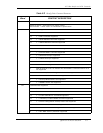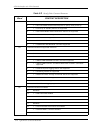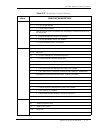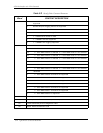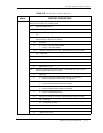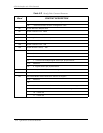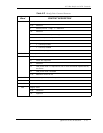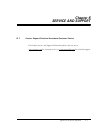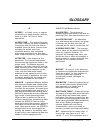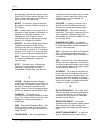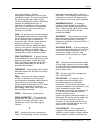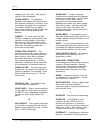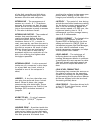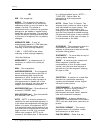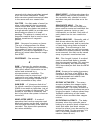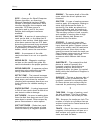
Quickview 40 20/30/40GB AT G-1
GLOSSARY
A
ACCESS – (v) Read, write, or update
information on some storage medium,
such as a disk. (n) One of these
operations.
ACCESS TIME – The interval between
the time a request for data is made by
the system and the time the data is
available from the drive. Access time
includes the actual seek time,
rotational latency, and command
processing overhead time. See also
seek, rotational latency, and overhead.
ACTUATOR – Also known as the
positioner. The internal mechanism
that moves the read/write head to the
proper track. The Maxtor actuator
consists of a rotary voice coil and the
head mounting arms. One end of each
head mounting arm attaches to the
rotor with the read/write heads
attached at the opposite end of each
arm. As current is applied to the rotor,
it rotates, positioning the heads over
the desired cylinder on the media.
AIRLOCK – A patented Maxtor feature
that ensures durable and reliable data
storage. Upon removal of power from
the drive for any reason, the read/write
heads automatically park and lock in a
non data area called the landing zone.
AIRLOCK allows the drive to withstand
high levels of non-operating shock.
When power is applied to the drive,
airflow created from the spinning disks
causes the AIRLOCK arm to swing
back and unlock the actuator, allowing
the heads to move from the landing
zone. Upon power down, the AIRLOCK
swings back to the locked position,
locking the heads in the landing zone.
A park utility is not required to park the
heads on drives equipped with
AIRLOCK (all Maxtor drives).
ALLOCATION – The process of
assigning particular areas of the disk to
particular files. See also allocation unit.
ALLOCATION UNIT – An allocation
unit, also known as a cluster, is a group
of sectors on the disk that can be
reserved for the use of a particular file.
AVERAGE SEEK TIME – The average
time it takes for the read/write head to
move to a specific location. To
compute the average seek time, you
divide the time it takes to complete a
large number of random seeks all over
the disk by the number of seeks
performed.
B
BACKUP – A copy of a file, directory,
or volume on a separate storage device
from the original, for the purpose of
retrieval in case the original is
accidentally erased, damaged, or
destroyed.
BAD BLOCK – A block (usually the size
of a sector) that cannot reliably hold
data because of a media flaw or
damaged format markings.
BAD TRACK TABLE – A label affixed to
the casing of a hard disk drive that tells
which tracks are flawed and cannot
hold data. The listing is typed into the
low-level formatting program when the
drive is being installed. Because Maxtor
disk drive’s defect-management
scheme handles all such flaws
automatically, there is no need to
concern yourself with bad track tables.
BIT – Abbreviation for binary digit. A
binary digit may have one of two
values—1 or 0. This contrasts with a



